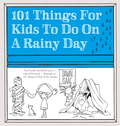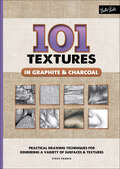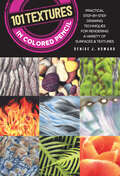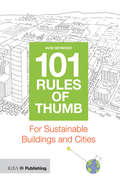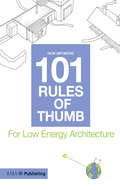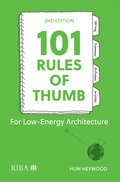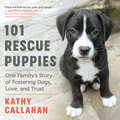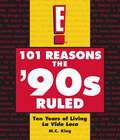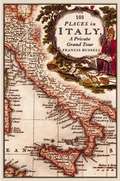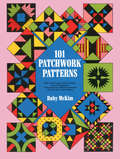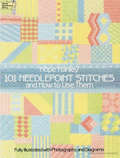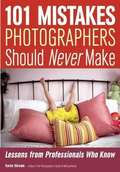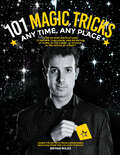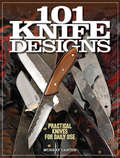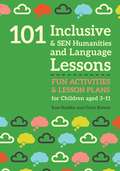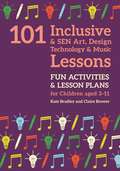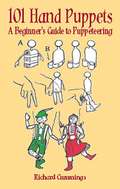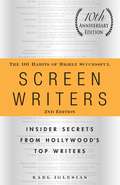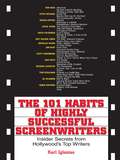- Table View
- List View
101 Things I Learned® in Fashion School (101 Things I Learned)
by Alfredo Cabrera Matthew FrederickA guide to surviving and thriving in fashion school, from an award-winning fashion designer and illustratorSuccess in fashion school requires more than a passion for fashion. It calls for the student to understand the cultural forces that shape what we wear and why we wear it; to develop a wide range of practical, aesthetic, and intellectual skills; and to work hands-on. This accessible guide assists the aspiring fashion designer on this journey with unique illustrated lessons on such topics as:• how to identify the target customer, set priorities, select fabrics, and integrate details• how to measure the human form, cut fabric, and pivot a dart• why you haven&’t designed a garment if you don&’t know how it will be made• how the nuclear bomb dropped on Hiroshima reshaped our understanding of fashion• illustration fundamentals, including proportions, poses, lighting, and rendering• practical information on the industry, including key terms, who does what in the industry, and the workings of the fashion calendarWritten by an experienced fashion designer, illustrator, and instructor, 101 Things I Learned® in Fashion School is an essential resource for beginning fashion students, recent graduates, experienced professionals, and anyone looking for a deeper understanding of how and why the clothes we wear—or choose not to wear—are designed and made.
101 Things I Learned In Architecture School
by Matthew Frederick2008 Silver Award Winner, Architecture Category, Independent Publisher Book Awards. and Winning entry, General Trade Illustrated Category, in the 2008 New England Book Show sponsored by Bookbuilders of Boston. This is a book that students of architecture will want to keep in the studio and in their backpacks. It is also a book they may want to keep out of view of their professors, for it expresses in clear and simple language things that tend to be murky and abstruse in the classroom. These 101 concise lessons in design, drawing, the creative process, and presentation--from the basics of "How to Draw a Line" to the complexities of color theory--provide a much-needed primer in architectural literacy, making concrete what too often is left nebulous or open-ended in the architecture curriculum. Each lesson utilizes a two-page format, with a brief explanation and an illustration that can range from diagrammatic to whimsical. The lesson on "How to Draw a Line" is illustrated by examples of good and bad lines; a lesson on the dangers of awkward floor level changes shows the television actor Dick Van Dyke in the midst of a pratfall; a discussion of the proportional differences between traditional and modern buildings features a drawing of a building split neatly in half between the two. Written by an architect and instructor who remembers well the fog of his own student days, 101 Things I Learned in Architecture Schoolprovides valuable guideposts for navigating the design studio and other classes in the architecture curriculum. Architecture graduates--from young designers to experienced practitioners--will turn to the book as well, for inspiration and a guide back to basics when solving a complex design problem.
101 Things I Learned in Architecture School
by Matthew FrederickConcise lessons in design, drawing, the creative process, and presentation, from the basics of “How to Draw a Line” to the complexities of color theory.This is a book that students of architecture will want to keep in the studio and in their backpacks. It is also a book they may want to keep out of view of their professors, for it expresses in clear and simple language things that tend to be murky and abstruse in the classroom. These 101 concise lessons in design, drawing, the creative process, and presentation—from the basics of "How to Draw a Line" to the complexities of color theory—provide a much-needed primer in architectural literacy, making concrete what too often is left nebulous or open-ended in the architecture curriculum. Each lesson utilizes a two-page format, with a brief explanation and an illustration that can range from diagrammatic to whimsical. The lesson on "How to Draw a Line" is illustrated by examples of good and bad lines; a lesson on the dangers of awkward floor level changes shows the television actor Dick Van Dyke in the midst of a pratfall; a discussion of the proportional differences between traditional and modern buildings features a drawing of a building split neatly in half between the two. Written by an architect and instructor who remembers well the fog of his own student days, 101 Things I Learned in Architecture School provides valuable guideposts for navigating the design studio and other classes in the architecture curriculum. Architecture graduates—from young designers to experienced practitioners—will turn to the book as well, for inspiration and a guide back to basics when solving a complex design problem.
101 Things I Learned® in Advertising School (101 Things I Learned)
by Matthew Frederick Tracy ArringtonProviding unique, accessible lessons on advertising, this title in the bestselling 101 Things I Learned® series is a perfect resource for students, recent graduates, general readers, and even seasoned professionals. The advertising industry is fast paced and confusing, and so is advertising school. This installment in the 101 Things I Learned® series is for the student lost in a sea of jargon, data, and creative dead-ends. One hundred and one illustrated lessons offer thoughtful, entertaining insights into consumer psychology, media, audience targeting, creativity, and design, illuminating a range of provocative questions: Why is half of advertising bound to fail? Why should a mug in an ad be displayed with its handle to the right? How did the ban on cigarette advertising create more smokers? Why do people fall for propaganda? When doesn’t sex sell? Written by an experienced advertising executive and instructor, 101 Things I Learned® in Advertising School is sure to appeal to students, to seasoned professionals seeking new ways to craft an ad campaign, and to small-business owners looking to increase awareness of their brand.
101 Things for Kids to do on a Rainy Day
by Dawn IsaacFrom the author of 101 Things for Kids to do Outside, which has fast become a go-to book for children and parents alike, comes this excellent new volume full of creative (and occasionally crazy) ideas for things to do when the weather is bad and you're stuck inside - without having to go any where near a TV or computer screen! Why not grow a windowsill herb garden, make your own jigsaw, or learn to play the glasses? Get crafty with decoupage and salt dough, or play detective by dusting for fingerprints. Exciting makes include terrariums and kaleidoscopes, whilst wacky games cover everything from Balloon Stomp to Sticky Note Scramble. All 101 ideas are designed to be achievable with little or no parental help, and only use materials that you already have around the house. With a wealth of creative and fun suggestions to keep you amused, you might not even notice that the rain has stopped.
101 Things for Kids to do on a Rainy Day
by Dawn IsaacFrom the author of 101 Things for Kids to do Outside, which has fast become a go-to book for children and parents alike, comes this excellent new volume full of creative (and occasionally crazy) ideas for things to do when the weather is bad and you're stuck inside - without having to go any where near a TV or computer screen! Why not grow a windowsill herb garden, make your own jigsaw, or learn to play the glasses? Get crafty with decoupage and salt dough, or play detective by dusting for fingerprints. Exciting makes include terrariums and kaleidoscopes, whilst wacky games cover everything from Balloon Stomp to Sticky Note Scramble. All 101 ideas are designed to be achievable with little or no parental help, and only use materials that you already have around the house. With a wealth of creative and fun suggestions to keep you amused, you might not even notice that the rain has stopped.
101 Textures in Graphite & Charcoal: Practical Drawing Techniques for Rendering a Variety of Surfaces & Textures
by Steven Pearce101 Textures in Graphite & Charcoal is a must-have resource for all graphite and charcoal artists. This guide provides step-by-step instructions on drawing key textures you'd find in any illustration. Accurately rendering surfaces and textures is one of the most challenging aspects of working with graphite pencil and charcoal. 101 Textures in Graphite & Charcoal provides artists with step-by-step instructions for learning how to draw a wide variety of the most common textures and surfaces, including sand, water, metals, foliage, wood, fabrics, stone, grass, hair, and many more. Opening with a general introduction to basic drawing tools, materials, and drawing techniques, each page in this comprehensive resource features two to three easy-to-follow steps demonstrating how to create each specific texture. You will will discover tips and techniques for working in both graphite and charcoal and how to manage their differences when hatching, stippling, scumbling, blending, and more. With its breadth of coverage, easy-to-follow instruction, and helpful tips, 101 Textures in Graphite & Charcoal is a must-have resource for artists of all skill levels.
101 Textures in Colored Pencil: Practical Step-by-Step Drawing Techniques for Rendering a Variety of Surfaces & Textures (101 Textures Ser.)
by Denise J. HowardCapture the feel of your subject on paper. Learn every technique you’ll need to give your colored-pencil drawings realistic, palpable texture.Named One of the 54 Best Colored Pencil Drawing Books of All Time by BookAuthority*There has never been a better opportunity to master textures. Knowing how to make your surfaces and textures look real is one of the most challenging aspects of creating art in colored pencil, even for experienced artists. 101 Textures in Colored Pencil provides artists with step-by-step instructions for drawing a wide variety of the most common textures and surfaces, including sand, water, metals, foliage, wood, fabrics, stone, grass, hair, and many more.To get you started, this comprehensive guide opens with a review of tools and materials as well as basic skills, such as strokes, effects, and color mixing. Plus, the book is organized into sections based on subject matter, so you can easily find the specific texture you’re looking for. Just a sample of the textures you will learn to render:People: smooth skin; aged skin; straight, curly, and wavy hair; lipsAnimals & Insects: smooth, curly, and course canine fur; elephant skin; feather; fish scalesFabrics & Textiles: burlap, tweed, silk, velvet, leather, lace, sequinsGlass, Stone, Ceramics, Wood & Metal: porcelain, polished silver, hammered brass, peeling paintFood & Beverage: red wine, cut citrus fruit, coconut, peach, dark chocolateNature: smooth and rough bark, moss, river pebbles, still and rippled lake, clouds101 Textures in Colored Pencil includes all the textures you need to create realistic masterpieces in colored pencil.
101 Rules of Thumb for Sustainable Buildings and Cities
by Huw HeywoodPeople across the world are becoming more aware of the need for the buildings and cities they live and work in to be sustainable, but the issue of how to be sustainable can seem a confusing and complex one. These rules of thumb provide universal guidelines for the sustainable design of both buildings and the urban realm. It’s a global primer and textbook for anyone interested in understanding sustainability in the built environment, an ideal starting point for students as well as an aide memoir for more experienced readers and practitioners interested in this field.
101 Rules of Thumb for Low Energy Architecture
by Huw Heywood101 Rules of Thumb sets out the essential elements of low energy architecture in a fresh, intuitive way. In an area where ever-changing technology and complex legislation and can cloud the designer’s thought-processes, this book encourages the designer to think clearly and intuitively about the fundamentals of low energy buildings. With reliable, simple rules of thumb that will provide new ideas and refresh the designer’s palette, each page focuses on a single piece of advice or guidance along with a clear hand-drawn illustration, while there are also plenty of tips and more detailed information for those who wish to dig deeper. The emphasis is on passive low-energy principles, and the rules of thumb cover all the design fundamentals from site and location to orientation and form, peppered with some which will help the designer to think ‘outside the box’ about the design process itself.
101 Rules of Thumb for Low-Energy Architecture
by Huw HeywoodBuildings and construction are a major contributor to the climate and biodiversity emergency. They account for nearly 40% of energy-related carbon dioxide (CO2) emissions. It is more important than ever for architects to design responsibly and create low-carbon, low-energy buildings for a sustainable future. 101 Rules of Thumb sets out the essential elements of low-energy architecture in a fresh, intuitive way. Where ever-changing technology and complex legislation can cloud the designer’s thought-process, this book equips you with the fundamentals you need to minimise CO2 emissions, design for low-energy use and work with, not against, the forces of nature. With reliable, simple rules of thumb, each page focuses on a single piece of guidance along with a clear hand-drawn illustration. The emphasis is on passive low-energy principles, and the rules of thumb cover all the design fundamentals from site and location to orientation and form, peppered with ideas to help the designer think outside the box, drawing inspiration from traditional methods, photoperiodic plants, and the black-tailed prairie dog. An extended, fully updated narrative bibliography explores the sources in detail and provides a valuable springboard for further study. Applicable throughout the world in any climate region, 101 Rules of Thumb is a global primer to be dipped into at any time as a quick means of re-focusing on what’s important when designing a new or retrofitted low-energy building. The rules cover: Site and location Orientation and form The low-energy building envelope Carbon free heating, cooling and lighting Passive low-energy principles.
101 Rescue Puppies: One Family’s Story of Fostering Dogs, Love, and Trust
by Kathy CallahanOver the past decade, Kathy Callahan&’s family has taken in more than a hundred rescue puppies. This delightful photo-filled book features the wonderful stories that emerged as these foster pups were suddenly surrounded by a nurturing family complete with patient adult dogs and curious cats. With a gift for capturing the moment in both words and images, Callahan brings readers inside the poignant and ultimately uplifting work of fostering. This inspiring read is indeed about puppies, but it&’s also about family and human connection. It&’s about finding your own way — through that one special thing you can do to light a candle, instead of cursing the darkness.
101 Reasons the '90s Ruled: Ten Years of Living La Vida Loca
by M. C. KingThe '90s were so money! Sit back and relive ten of the best years of your so-called life... Presidential scandals, rap feuds, Baywatch -- the '90s had it all. It was the decade during which we first visited 90210 and had coffee with our Friends. We got on the Web and started to Google and lol. We learned that a show about nothing can definitely be something, and that men and women hail from different planets! (Who knew?) And for at least a second or two, we may have wondered whether the Blair Witch was real. The perfect companion to E!'s 101 Reasons the '90s Ruled miniseries, this book relives memorable moments from a momentous decade. Every page will make you say, "Dude, I totally remember that." Unless, of course, you are very, very young (or don't call people dude). Packed with cool photos and irreverent commentary, 101 Reasons the '90s Ruled is Absolutely Fabulous.
101 Places in Italy: A Private Grand Tour
by Francis Russell"The author has achieved the near impossible...a must-squeeze-into-hand-baggage or the back pack."--House and Garden"A minor classic."--The Times Literary SupplementThis personal, and wonderfully well-informed, selection of the most rewarding towns, cities, villages, and individual monuments in Italy is the definitive guidebook for the discerning traveler. The author has been visiting Italy, for study, for work, and for pleasure, for over fifty years, and is the perfect companion for those who want to know about more than the obvious attractions.As well as comprehensively covering the finest sights in the major tourist centers of Rome, Florence, Venice, and elsewhere, Francis Russell discusses and describes the neglected, or little-known, masterpieces that are still to be found the length and breadth of the Italian peninsula. In a book that will educate and astonish the expert as surely as it will guide and inform the first-time visitor, the author chooses and explores palaces and gardens, city squares and lonely churches, frescoes and altarpieces, great museums and tiny ruins that together provide a richly textured portrait of a country where the history and patterns of civilization lie more thickly than anywhere else on earth.This book will immeasurably enhance and enrich the visitor's experience of the most visited country in the world, by virtue of its sensitivity, its wisdom, and its deep knowledge, and by means of its vivid, eloquent, and entertaining exposition.Francis Russell was educated at Oxford. He is deputy chairman of Christies and specializes in Old Master and Italian paintings.
101 Patchwork Patterns
by Ruby S. MckimThis is one of the finest of all the available books on the making of patchwork quilts. The author is recognized as having been one of our country's leading authorities on this venerable art, and in this book she divulges many a secret that will assist you in making quilts of the highest quality.The book contains over 100 patchwork patterns, with complete instructions for cutting and sewing. All conceivable sorts of designs are diagrammed and carefully described: flower designs, rainbows designs, Irish chains, fish and bird and leaf designs. The book shows you, step by step, all the details of making each kind of quilt: it covers choice of pattern, piece vs. patch quilting, simple and complex quilts, choice of quilt materials, interlining materials, lining and thread materials, cutting and piecing, the applique process, various methods of setting together, quilt sizes, borders, scallops, flounces, valances, straight line and close shell quilting, methods of stamping, perforated quilting patterns, quilting the quilt, putting into frames, quilting in a small space, embroidery quilts, and many other topics.The book is written in an entertaining manner. The author weaves a great deal of rosy humor into the lining of her instructions, as well as some interesting facts about the history of quilting, quilt materials, patterns, and some really choice folklore about the origin of the highly ingenious names of the patterns: "Monkey Wrench," "Road to California," "Lafayette Orange Peel," "Drunkard's Path," and "Crossed Canoes," to name a few.The book is not technical in any sense of the word. You can use it to make beautiful quilts provided only that you know the fundamentals of sewing.
101 Needlepoint Stitches and How to Use Them: Fully Illustrated with Photographs and Diagrams (Dover Embroidery, Needlepoint)
by Hope HanleyTired of doing the same basic stitches over and over again? Noted designer Hope Hanley can help you bring new excitement and beauty to your needlepoint in more than a hundred different ways. In this practical, extremely well-organized guide she presents a treasury of 101 decorative stitches, with an easy-to-read chart and an actual-size photograph for each one.Only stitches which adequately cover the canvas have been included in this versatile collection. In Tapestry no warp threads are allowed to show through, so why let canvas show in needlepoint? Enhance and individualize your needlepoint projects with expert advice on a host of exquisite stitches: rep stitch; fancy cross stitch; Renaissance stitch; cross stitch; Herringbone stitch; shaded stripe stitch; double stitch; mosaic stitch; French stitch; Greek stitch; velvet stitch; closed cat stitch; and scores more.The author explains precisely where and how to make best use of each stitch (as a filling stitch in small areas, as a background or a grounding pattern), and tells whether each is slow or quick to work up and whether it's best on mono or two-thread canvas. No stitch combinations have been included, just the fundamental stitch. Think up your own combinations -- there are hundreds of them!Whether you're a beginner, intermediate, or advanced needleworker, give your needlepoint a vibrant new look with this modestly priced, indispensable reference work.
101 Mistakes Photographers Should Never Make: Lessons from Professionals Who Know
by Karen DorameKaren Dorame presents hard-won tips and techniques that allow you to smooth out the bumps in the road toward a career in professional photography. She covers equipment selection and use, light source options and lighting setups using natural light and studio lighting, and shows you how to get the most out of your store-bought backgrounds and posing aids and "found” backgrounds and posing implements on location. You’ll find sage advice on avoiding posing mistakes for individuals and groups. Of course, Dorame also offers pointers on avoiding common post-production traps, saving you time, frustration, and compromised image quality. The balance of the book details problems that aspiring professionals often face in handling the business side of photography. You’ll learn what not to do when it comes to booking sessions, conceptualizing shoots, and more. Finally, you’ll learn how to weather the changes and stay at the top in this exciting, demanding field.
101 Magic Tricks: Any Time, Any Place
by Bryan MilesAstonish and amaze with step-by-step instructions for 101 simple, mind-blowing magic tricks—no fancy equipment needed!Ladies and gentlemen, boys and girls. Step right up and try not one, not two, not three, but 101 Magic Tricks! Delight kids and adults alike with easy-to-master tricks and illusions.Learn classic sleight-of-hand techniques that are simple enough for any apprentice to grasp. Conquer magical ruses that require no special equipment, and are explained with simple step-by-step instructions. Award-winning magician and mentalist Bryan Miles will guide you through The Foundations of Magic including: The Hand, The Deck of Cards, Mechanic’s Grip and Biddle Grip, Classic Two-Handed Spread, and Cutting the Cards.
101 Knife Designs
by Murray CarterGreat designs, great knives! In 101 Knife Designs, join master smith Murray Carter as he reveals the successful traits of knife designs that have lasted throughout history. Knife enthusiasts and knife makers alike will learn to: Identify common traits in great knives. Understand how to apply them to new knife design. For the first time ever, Carter shares details of his personal collection of successful patterns--created and perfected over decades of designing and making knives. Dazzling, full-color images of completed knives--from renowned photographer Hiro Soga--provide inspiration and direction as you apply these principles to create your own custom knife designs. With 101 Knife Designs, you, too, can make practical knives that will become cherished keepsakes.
101 Inclusive and SEN Humanities and Language Lessons: Fun Activities and Lesson Plans for Children Aged 3 - 11
by Kate Bradley Claire BrewerCreate an inclusive classroom for all with this resource. From Sensory Box Fire Station to Victorian Me, this book is overflowing with ideas for engaging and accessible Geography, History and Language lessons. Each lesson is tailored for children working below National Curriculum levels and includes a learning objective, the resources needed, the main activity, a plenary and a consolidation activity to help support children's understanding.The activities in this book have been specifically designed to promote fine and gross motor skills and utilise lots of visual stimulus, which is important for working with children with SEN. This straightforward and practical book offers you 101 creative classroom activities for teaching Humanities and Languages to pupils who are working below national curriculum levels, as well as mapping the range of additional skills they will acquire.
101 Inclusive and SEN Art, Design Technology and Music Lessons: Fun Activities and Lesson Plans for Children Aged 3 – 11
by Kate Bradley Claire BrewerCreate an inclusive classroom for all with these fun and accessible activities for Art, Design Technology and Music lessons. Each lesson is tailored for children working below National Curriculum levels and includes a learning objective, the resources needed, the main activity, a plenary and a consolidation activity to help support children's understanding. Activities such as 'Peg Painting' and 'Build my Car' build visual, auditory, social communication and fine motor skills and support self-esteem and mental wellbeing.The 101 creative activities in this book aim to support the ever-increasing demands on teachers to meet the needs of the growing number of SEN learners in mainstream settings. It also offers practical lesson plans that have been specifically designed to promote fine and gross motor skills and utilise lots of visual stimulus.
101 Hand Puppets: A Beginner's Guide to Puppeteering
by Richard CummingsThis entertaining how-to book, with its simple, step-by-step instructions, makes it easy to create every kind of puppet imaginable — from such handkerchief varieties as Spook-a-boo the Ghost (made with a simple twist of the wrist) for beginners and Flak J. Frog for performers at the intermediate level, to such special figures as a Box of Demons for advanced puppeteers who want to expand their cast of characters.A host of charming little personalities lead the way, among them such "instant" puppets as Bagdad, the paper bag gremlin; the Matchbox Monster, Spoonerella, and Carrie Carrot; "rainy day" puppets that include Robert Robot, Little Miss Muffet, Perky Pup, and Gordo the Wizard; professional puppets such as Pat the Policeman, Bird McDermitt, Klondike Kitty, Honk Kong, the Ape; and dozens of other delightful figures.Scripts for three plays as well as simple designs for stages and props are included, allowing performers of all ages to put on their own shows and have fun bringing their creations to life.
The 101 Habits of Highly Successful Screenwriters, 10th Anniversary Edition
by Karl IglesiasYou can struggle for years to get a foot in the door with Hollywood producers--or you can take a page from the book that offers proven advice from twenty-one of the industry's best and brightest! In this tenth anniversary edition, The 101 Habits of Highly Successful Screenwriters, 2nd Edition peers into the lives and workspaces of screenwriting greats--including Terry Rossio (the Pirates of the Caribbean franchise), Aline Brosh McKenna (Morning Glory), Bill Marsilii (Deja Vu), Derek Haas and Michael Brandt (Wanted), and Tony Gilroy (the Bourne franchise). You will learn best practices to fire up your writing process and your career, such as: Be Comfortable with Solitude Commit to a Career, Not Just One Screenplay Be Aware of Your Muse's Favorite Activities Write Terrible First Drafts Don't Work for Free Write No Matter What This indispensable handbook will help you hone your craft by living, breathing, and scripting the life you want!
The 101 Habits of Highly Successful Screenwriters, 10th Anniversary Edition: Insider Secrets from Hollywood's Top Writers
by Karl IglesiasYou can struggle for years to get a foot in the door with Hollywood producers--or you can take a page from the book that offers proven advice from twenty-one of the industry's best and brightest!In this tenth anniversary edition, The 101 Habits of Highly Successful Screenwriters, 2nd Edition peers into the lives and workspaces of screenwriting greats--including Terry Rossio (the Pirates of the Caribbean franchise), Aline Brosh McKenna (Morning Glory), Bill Marsilii (Deja Vu), Derek Haas and Michael Brandt (Wanted), and Tony Gilroy (the Bourne franchise).You will learn best practices to fire up your writing process and your career, such as:Be Comfortable with SolitudeCommit to a Career, Not Just One ScreenplayBe Aware of Your Muse's Favorite ActivitiesWrite Terrible First DraftsDon't Work for FreeWrite No Matter What This indispensable handbook will help you hone your craft by living, breathing, and scripting the life you want!
The 101 Habits Of Highly Successful Screenwriters
by Karl IglesiasInsider Secrets from Hollywood's Top WritersThis book not only shows how to be a screenwriter, but what it's actually like to be one. An inspiration to all would-be screenwriters, this book is about living the screenwriter's life -- the habits, writing environments, creative processes, daily passions, and obsessions. In The 101 Habits of Highly Successful Screenwriters, author Karl Iglesias has interviewed 14 top contemporary Hollywood screenwriters who offer their experience, insight, and advice to aspiring screenwriters everywhere.




